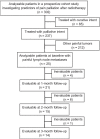Palliative radiotherapy for painful lymph node metastases
- PMID: 34530897
- PMCID: PMC8447670
- DOI: 10.1186/s13014-021-01900-8
Palliative radiotherapy for painful lymph node metastases
Abstract
Background: There is limited evidence concerning radiotherapy for painful lymph node metastases (PLM). We evaluated the effectiveness of radiotherapy for PLM using the International Consensus Endpoint in a subgroup analysis of a prospective observational study.
Methods: In the primary study, 302 patients received radiotherapy for painful tumors. Among them, those treated with palliative radiotherapy for PLM were analyzed in the present study. We used the Brief Pain Inventory short form to evaluate the intensity of pain and the pain interference in patient's life. We collected the Brief Pain Inventory and analgesic data at baseline and at 1, 2, and 3 months after the start of radiotherapy. Pain response was assessed using the International Consensus Endpoint. Patients were diagnosed with a predominance of other pain (POP) if non-index pain of a malignant or unknown origin was present and had a greater 'worst pain' score than the index pain.
Results: Radiotherapy for PLM was performed on 25 patients. In total, 15 (60%) patients experienced a pain response. The pain response rates for evaluable patients were 66%, 67%, and 57% at 1-, 2-, and 3-month follow-ups, respectively. At baseline and at 1, 2, and 3 months, the median index pain scores were 7, 2, 0, and 0.5, respectively. At 1 month, all pain interference scores were significantly reduced from baseline. Four (16%) patients experienced POP within three months.
Conclusion: Radiotherapy for PLM improved pain intensity and pain interference. Palliative radiotherapy may be a viable treatment option for PLM.
Keywords: Pain interference; Painful lymph node metastases; Palliative radiotherapy; Predominance of other pain.
© 2021. The Author(s).
Conflict of interest statement
Not applicable.
Figures



Similar articles
-
Palliative radiotherapy for painful non-bone lesions in patients with advanced cancer: a single center retrospective study.Jpn J Radiol. 2024 Jun;42(6):656-661. doi: 10.1007/s11604-024-01536-0. Epub 2024 Feb 22. Jpn J Radiol. 2024. PMID: 38386259 Free PMC article.
-
Possible Dose-Response Relationship in Palliative Radiotherapy for Non-bone Painful Lesions.Clin Oncol (R Coll Radiol). 2019 Jun;31(6):391-398. doi: 10.1016/j.clon.2019.03.042. Epub 2019 Apr 5. Clin Oncol (R Coll Radiol). 2019. PMID: 30955989
-
Predictors of Pain Palliation After Radiation Therapy for Painful Tumors: A Prospective Observational Study.Int J Radiat Oncol Biol Phys. 2018 Aug 1;101(5):1061-1068. doi: 10.1016/j.ijrobp.2018.04.072. Epub 2018 May 4. Int J Radiat Oncol Biol Phys. 2018. PMID: 29885995
-
Pain Response Rates After Conventional Radiation Therapy for Bone Metastases in Prospective Nonrandomized Studies: A Systematic Review.Pract Radiat Oncol. 2019 Mar;9(2):81-88. doi: 10.1016/j.prro.2018.11.006. Epub 2018 Nov 30. Pract Radiat Oncol. 2019. PMID: 30508601
-
Palliative Reirradiation for Painful Bone Metastases: Clinical Cases and Literature Review.Kurume Med J. 2018 Feb 26;64(1.2):5-11. doi: 10.2739/kurumemedj.MS6400004. Epub 2017 Dec 15. Kurume Med J. 2018. PMID: 29249780 Review.
Cited by
-
Shortened Palliative Radiotherapy Results in a Lower Rate of Treatment During the Last Month of Life.Cureus. 2022 Jan 25;14(1):e21617. doi: 10.7759/cureus.21617. eCollection 2022 Jan. Cureus. 2022. PMID: 35233303 Free PMC article.
-
Quality of life improvement in patients with bone metastases undergoing palliative radiotherapy.Rep Pract Oncol Radiother. 2022 Jul 29;27(3):428-439. doi: 10.5603/RPOR.a2022.0048. eCollection 2022. Rep Pract Oncol Radiother. 2022. PMID: 36186707 Free PMC article.
-
Travel distance and potential disparities in palliative radiotherapy access for cancer patients in Victoria, Australia.Strahlenther Onkol. 2025 Aug 22. doi: 10.1007/s00066-025-02418-8. Online ahead of print. Strahlenther Onkol. 2025. PMID: 40846779
-
Palliative radiotherapy for painful non-bone lesions in patients with advanced cancer: a single center retrospective study.Jpn J Radiol. 2024 Jun;42(6):656-661. doi: 10.1007/s11604-024-01536-0. Epub 2024 Feb 22. Jpn J Radiol. 2024. PMID: 38386259 Free PMC article.
-
Palliative radiotherapy for painful non-bone-metastasis tumors.Int J Clin Oncol. 2025 Aug;30(8):1500-1504. doi: 10.1007/s10147-025-02803-4. Epub 2025 Jun 3. Int J Clin Oncol. 2025. PMID: 40459659 Review.
References
Publication types
MeSH terms
LinkOut - more resources
Full Text Sources
Medical

